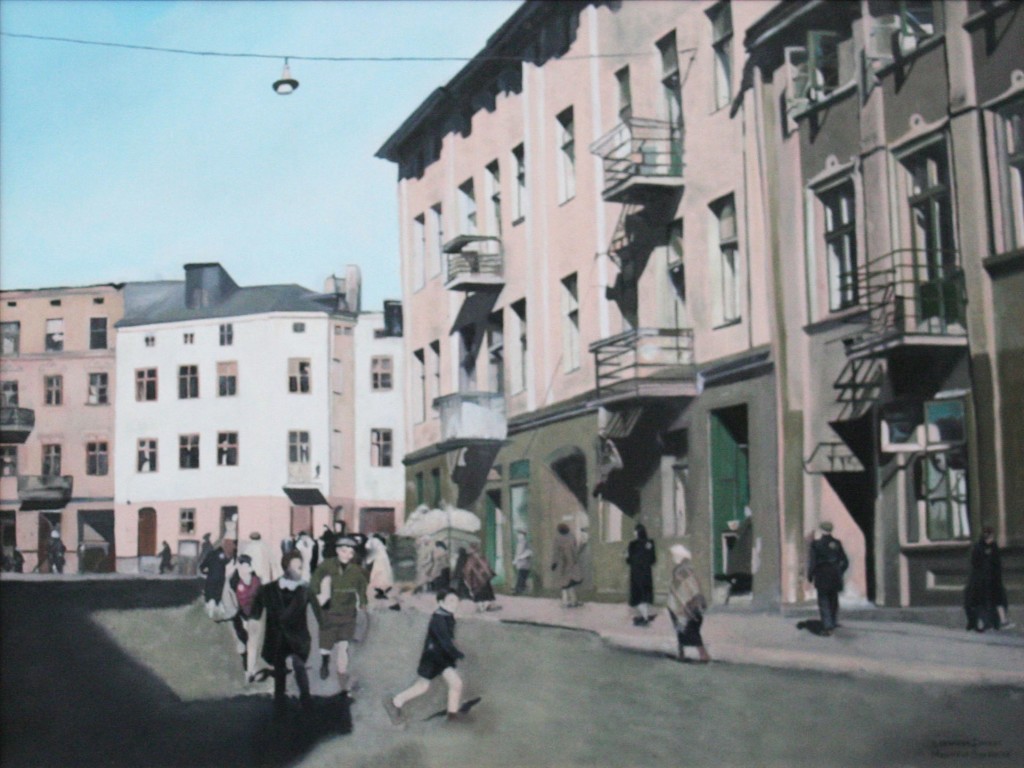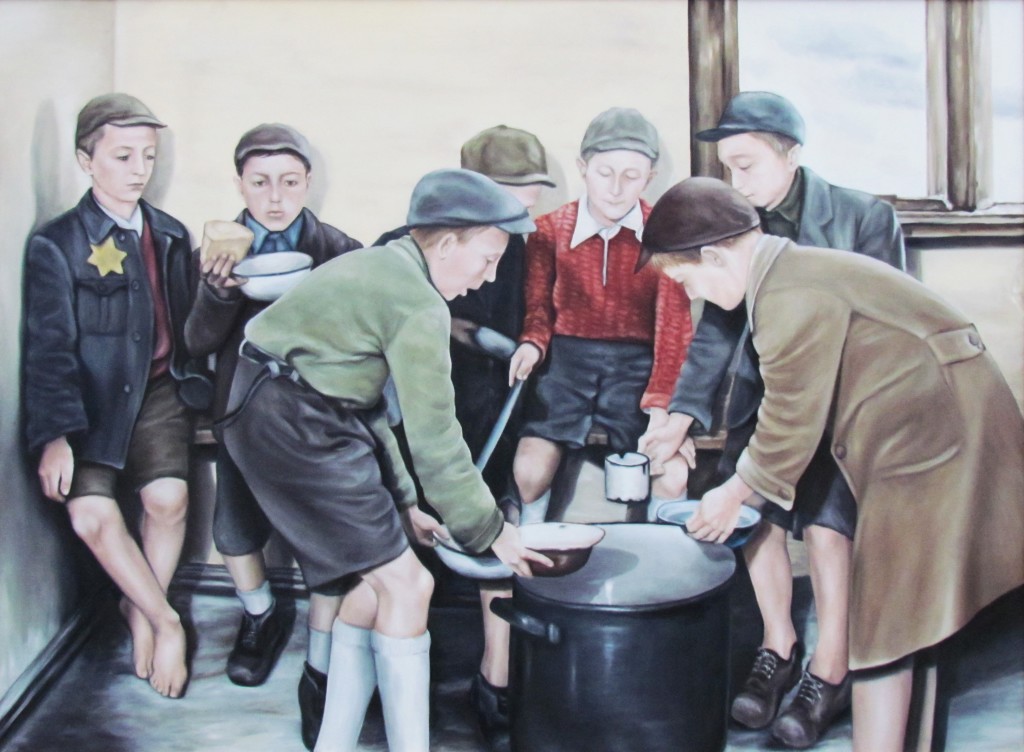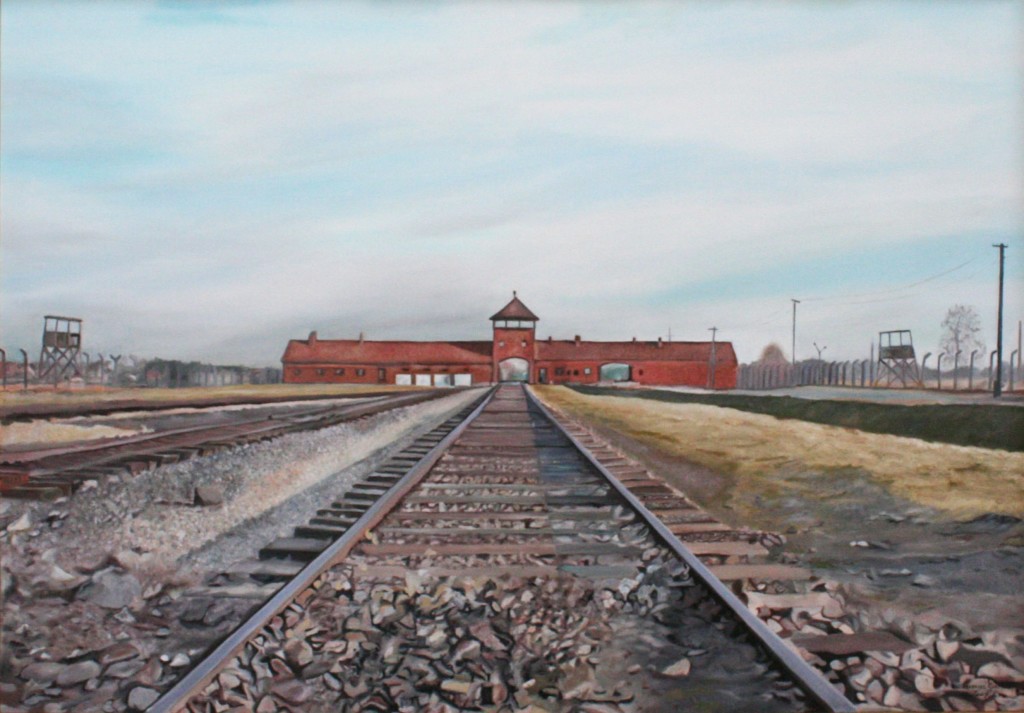Henry Nekrycz (Ben Abraham) was born in Lodz in 1924. Although his grandfather was the director of one of the largest synagogues in the city, he was not raised as an Orthodox Jew. Unlike his cousin Moniek, who had strictly orthodox parents, he did not wear “kaftan with tzitzit” or “pejelech”. His family owned the building where they lived in an apartment with two bedrooms.

Ben Abraham was 14 years old when the war reached his home town. On September 1st, 1939, the Germans bombed a building close to his house. On September 6th, he saw panic overtake Lodz as all men were summoned to Warsaw and began leaving the city. He tried to accompany the rest of the men in his family to the capital. Along the road, he could see the lines of desperate crowds of people trying to get to the capital, cars left behind without fuel, the sick that could no longer move on and were simply abandoned, and the dead that had fallen along the way. He gave up going to Warsaw and returned to Lodz, where only women and children could be seen in the streets.
Even before the fall of Warsaw and as soon as the Germans came to Lodz, Ben Abraham realized the Jews were facing severe persecution. Jews were caught in the streets and sent to do heavy labor. The Jewish leaders began to disappear, as well as the artists, writers, and intellectuals. Polish-Germans invaded Jewish homes, looted them and expelled their inhabitants.
On September 26th, Warsaw fell to Germany and the Polish who, despite being enemies of the Germans, were united with them in the persecution against the Jews. Sometime after that, Ben Abraham’s father came home wounded one day. He had been beaten by a group of Germans living in the neighborhood.
In October Ben Abraham heard the first rumors of the creation of a ghetto. The Jews would be transferred to the dirtiest neighborhood in Lodz, Baluty, from where the Polish population would be deported to the occupied central area of Poland. As the persecution intensified, he witnessed the Nuremberg laws being put into practice – Jews were forbidden to keep their religious holidays and their synagogues were burned down.
On October 15th, Ben Abraham’s family was expelled from their home and their goods were confiscated by the Gestapo. They were then deported to the ghetto, according to the German plan of a 3-month evacuation of all Jews. After many of the Jews were killed in the public square, all of the existing survivors were forced to flee into the ghetto.
As winter came, Ben Abraham, his parents, grandfather, and uncle were living in the crowded ghetto. The rest of the family had fled to another town. They had no wood, and the water froze in the bucket.
On May 1st, 1940, the ghetto was sealed. As Ben Abraham could not leave the ghetto, he was able to see from behind a fence of barbed wire the cart that would cross Lodz.There was a bridge built across the street linking the two parts of the ghetto. Many times he saw Germans shooting at the Jews walking on the bridge, simply for target practice. He also saw the elderly and the sick that had difficulty climbing those steps.
Lodz was incorporated into the Reich and its name was changed to “Litzmannstadt,” in honor to the German General that had conquered it in WWI.

As famine increased in the ghetto, Ben Abraham escaped by crawling under the fence to look for a German that owed some money to his grandfather.
In the summer, the first schools started in the ghetto, and Ben Abraham was enrolled in a school for smiths. He did not learn the trade, but his hands became very calloused and capable of doing any manual work. He also started a small garden plot of potatoes, radishes, lettuce, and parsley.
By this time, a new aristocracy began to be formed in the ghetto, which caused a revolt among the other Jews. The Jewish police increased after the incident, and the Nazis would go from house to house trying to find anything valuable that they could confiscate. The Krypo, a special German police, also searched for the Jews’ belongings and tortured those they believed were hiding something. A new currency was issued in the ghetto, the “Rumki”, and the Jews were forbidden to possess any German marks. In 1940, the first uniform factories were installed in the ghetto, but the Jewish hierarchy controlled the choice of workers.
In the winter, the ghetto received a supply of potatoes and vegetables in exchange for gold, silver and dollars. Rumkowski, the ghetto’s president, did not want to distribute everything immediately; unfortunately, because it was so cold, the potatoes froze and could no longer be eaten. The ration a person could get was “latques” (a kind of cake made with frozen potatoes), seven ounces of bread and a tablespoon of sugar. Once a month they also got a quarter pound of horse meat. In the meanwhile, the ghetto became increasingly dirty and infested with lice. The population of the ghetto also continued to increase, with the arrival of Jews deported from Germany and Czechoslovakia. At this point, Ben Abraham finally found a job as a joiner, receiving two Rumkis per day as his salary. With that money he could buy the rations.

In the following spring, one of Ben Abraham’s uncles was put in charge of organizing a metallurgic factory, so he got a job in the sector where kettles were made. Nonetheless, he soon became affected by the fumes that came from the hydrochloric acid that he used to whiten the kettles. Therefore, he got another job as an auxiliary welder. However, he again had to withdraw from his job because his eyes were soon affected by the welding sparks. He was very much afraid of becoming blind, so he told the manager of the factory he wanted to become a mechanic. He was transferred to another office where this manager soon found out that he was totally unfamiliar with the job, but allowed him to stay anyway. Despite the hunger, he was happy to have a job with which he could buy the rations for his family.
On June 22nd, news came about Russia entering the war, making those in the ghetto hopeful that the war would end soon, but as the Germans beat them back, their hopes began to fade. By this time, new factories were set up in the ghetto and his parents managed to get jobs: his father went to work in the construction of a road and his mother got a job as a seamstress. Since the prices of the rations increased continually, the fact that the family was making more money did not help much.
In the winter of 1942, Ben Abraham’s father got a better job in a joinery. One day he arrived home very sad, because two Jews had been hanged in the ghetto’s square. Their crime was having left the ghetto to buy potatoes.
In the spring of 1942, Ben Abraham was transferred to a uniform factory with 500 sewing machines, where he learned how to fix them. By this time, he witnessed the first deportation of sick people from the ghetto. They were taken out of their hospital beds and cruelly thrown into trucks While most of the population of the ghetto suffered from hunger and poverty, the police officers, high officials, and factory managers had not only the food but also the ability to rent the available properties in the ghetto.
The family was then expelled from the house where they lived to give place to a Sonderkommando officer. They moved to a much smaller home and shared it with another family.
By late September, 1942, Ben Abraham saw Rumkowksi addressing a crowd in a speech. He said that the Germans demanded 20,000 Jews to be deported, recommending that the old and the sick present themselves voluntarily. The children should also be delivered up by their mothers, thus creating better chances of surviving the ghetto.

Since nobody volunteered and the mothers attacked the German policemen with hot water in search of their children, riot troops of the SS decreed a state of emergency so that no one was allowed to leave their homes. The soldiers came and surrounded one block after the other, ordering everyone to come out into the street. The old, the sick and the children were taken in trucks.
At this point, Ben Abraham’s father became very sick, and died a few days later. Ben was now left alone with his mother. The next day, when they heard the SS would surround their block, they fled to a more distant quarter and found a woman that allowed them to stay with her. She had lost all the members of her family.
The quota of 20,000 Jews was met that week. The deported Jews were assassinated in Chelmno.
Despite the fact that now there were less people in the ghetto, the Germans demolished it little by little, with the pretext of building a road to Moscow. Ben Abraham and his mother received orders to move away from their room. His mother found a smaller room in which they could move after paying two hundred marks and around four and a half pounds of bread. His mother made the money selling her quota of sugar, and saving their bread rations for two weeks. The conditions in their room were terrible, but Ben Abraham found strength to work every day fixing sewing machines.
Ben Abraham became ill with typhus and recovered after twenty-one days, due in part to the help of a Jewish doctor that lived in the same building. When he came back to the factory, he found out that he was considered dead and the manager did not want to admit him back because his name was no longer on the list. After much discussion, his situation was settled and he was allowed back to work. He was transferred to two different factories, where he spent hours lying on the floor in order to build supports for the machines. As it was winter, the floor was very cold and he felt that he would soon get sick, which happened fast; again he became ill with pleurisy.
After being advised by the same Jewish doctor, his mother somehow sold a piece of clothing made of fox skin which she had hidden from the Germans and bought five injections of calcium. She also found a nurse to give him the injections. During this time, the manager of the factory where he worked sent him his daily soup.
In March Ben Abraham was already back to work. Because they were deporting all the sick, the manager had not reported his illness to the Germans, although he had been absent for five months. During this time, he also received his normal salary.
Ben Abraham continued to work on fixing sewing machines, and was eventually recognized for his ability. Since this skill was crucial for the survival of the ghetto as economically useful to the Germans, this ability brought him a higher status in the factory. His salary increased and he could get better rations for him and his mother.
At the same time, as the Russians advanced and the Allies arrived in Normandy, the Germans ordered all the population of the ghetto to be deported to Germany. The commissary of the ghetto told the Jews that the “Führer” needed them to produce uniforms there. At that point, those still in the ghetto knew nothing about Treblinka, Majdanek or other extermination camps.
Ben Abraham and his mother were summoned to present themselves for the deportation, but they decided to hide together until the Russians arrived. Their quarter was surrounded by heavily armed SS officers, who searched their apartment but failed to find their hiding place.
As the policemen continued to search block after block in order to deport all the Jews, Ben Abraham and his mother decided to go to the factory where he prepared a hiding place in case the SS arrived. Other employees of the factory were also hiding there with their families – twenty-six people in all. But the SS finally came and deceived the manager of the factory by telling all of them that they just needed to present themselves and would soon be released. It was a trap; they were all put in carts and taken to a railroad, where they were put into cargo trains locked from outside. The prisoners were told that they were going to Germany to work.

After some time, they arrived at what seemed to be a train station. He could see barbed wire and many soldiers carrying heavy guns, and men with their heads shaved wearing striped uniforms.
They had just arrived at Auschwitz.
Continue reading: Two Weeks in Auschwitz